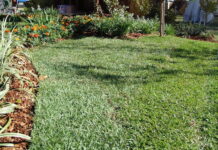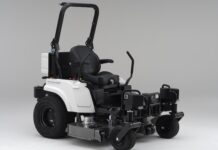Landscapers who take the time to proactively address equipment and staffing needs will be the ones best positioned to thrive this year.
Content Sponsored By

With warmer temperatures around the corner, landscapers across the country are setting their sights on the 2022 spring and summer seasons. And regardless of when spring actually springs in your area, how you prepare in these next few weeks can make all the difference.
Here are four things you can (and should) do now to set your landscaping business up for success this year.
Evaluate Past Performance
Conducting a postmortem of the previous year is an essential step in improving future outcomes. While it may be tempting to leave the past in the past, there are valuable learnings and insights to be gained from what worked and, more importantly, what didn’t.
If you haven’t already, take time to sit down and review last year. Identify challenges you encountered and reflect on how you would react differently. Were there common pain points, customer feedback and processes that need to be addressed? Remember to include key members of your team in these conversations. They can offer valuable and alternative perspectives that paint a clearer picture of what happened. Plus, these retrospective exercises give them an opportunity to share their opinions and feel like they’re helping to shape the future of the business.
Finally, these conversations aren’t just about working out kinks and gaining insights into your business’s performance. Reviewing key metrics such as past accounts receivable totals, work order statuses and schedule capacities can provide insights into where there are opportunities for expansion. Because at the end of the day, it’s far more difficult to improve and grow what hasn’t been measured.
Finalize Your Marketing And Sales Plans
After gaining insights from the past, it’s time to look to the future. Building an effective marketing and sales plan is fundamental to any landscaping business. It provides a strong foundation to start the year and milestones to evaluate against throughout the season. Yes, things seldom go according to your exact plan, but being able to pivot elements from an existing plan is far easier than improvising from scratch.
When developing your plan, start with a revenue goal. Be realistic, but don’t shy away from growth. Estimate your cost per sale to help you understand what you need to invest in your sales and marketing budget to reach your growth goal. Next, build out a marketing calendar. Map out what pieces and efforts —direct mail, digital advertisements, social media, customer events, etc.— need to be planned and created to take advantage of the spring selling season. Finally, be sure to continue to engage your customers in discussing budgets and projects, and create detailed work orders for your team. Listing the hours bid and goals for each job helps them know exactly what numbers to hit for each property. Because ultimately, accountability starts with setting clear expectations.
Equip Your Business For Growth
The bones of any landscaping business are its equipment. When they break or don’t perform, your operations can quickly come to a halt. To prepare for the upcoming season, audit your equipment and determine what overhauls and maintenance need to be done. For your mower fleet, be sure to change the oil and filters, inspect belt conditions and check the tire pressure. While mostly routine, these tasks can slip through the cracks as the busy spring season ramps up.
This is also the time of year for new equipment decisions and purchases. If you’re planning for growth, look beyond simply replacing current mower units and determine what upgrades are needed to take on new and more jobs. Think efficiency, productivity, reliability, durability, comfort and feature upgrades to help take your business to the next level. And always be willing to try something different. Whether it’s new mower products or even manufacturers, demo different machines and get a feel for how they operate to ensure you’re investing in those that work for your business.
Staff Early, Train Early
If equipment are the bones of your business, then employees are its lifeblood. And given tight labor markets, this is not the year to procrastinate identifying and recruiting employees. Staffing up will take more time and resources this year, and businesses that don’t prioritize it will likely find shortages holding them back from their full potential and goals. When looking for new labor, prioritize asking current employees for referrals, network with other business leaders, include a link for employment inquiries on your website and reach out to local community colleges.
In a perfect world, all your employees will have landscaping experience; however, you realistically will be dealing with several fresh faces to the industry. While it may be tempting to go with a learn-on-the-job approach, proactive and intentional training can help increase day-one productivity and limit potential pitfalls.
In addition to training, you can look at investing in technology that drastically lowers the learning curve and ups the overall productivity for new and returning employees. For example, Cub Cadet® PRO ZTM 960 S and 972 S SurePath™ units are outfitted with GPS technology and an exclusive four-wheel steering system that provide a semi-autonomous experience designed to maximize efficiency and productivity while minimizing effort and training. The operator simply sets the preliminary cut line and the SurePath™ units will perform straight cutting paths with an auto zero-turn at the end of each row at the touch of a button. Because of the intuitive nature of the GPS technology, operators, from new hires to landscaping vets, can be expected to deliver consistent quality cuts and efficient operation when using a SurePath™ unit.
Landscapers who take the time to learn from the past, plan for the future and proactively address equipment and staffing needs will be the ones best positioned to thrive this year. And while unexpected hurdles and new challenges are all but guaranteed, starting the process now will pay dividends down the road and set you up for long-term success.











![[VIDEO] Dickies®: Discover Workwear That’s Anything But Uniform](https://turfmagazine.com/wp-content/uploads/2023/06/1647663814-4b1a2a7742790a9b1e97a3b963477850192e1d6a9dfba9b07214a77bae25d6e3-d-218x150.jpg)































![[VIDEO] Dickies®: Discover Workwear That’s Anything But Uniform](https://turfmagazine.com/wp-content/uploads/2023/06/1647663814-4b1a2a7742790a9b1e97a3b963477850192e1d6a9dfba9b07214a77bae25d6e3-d-324x160.jpg)